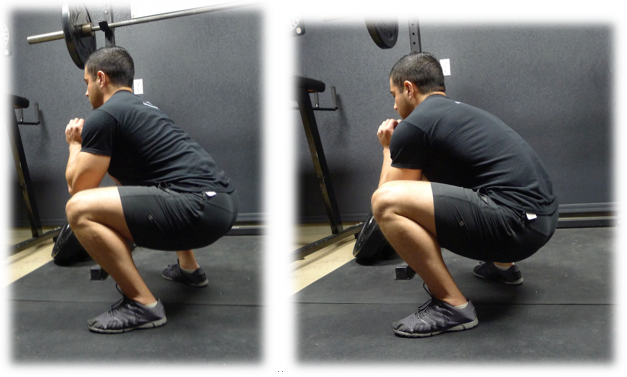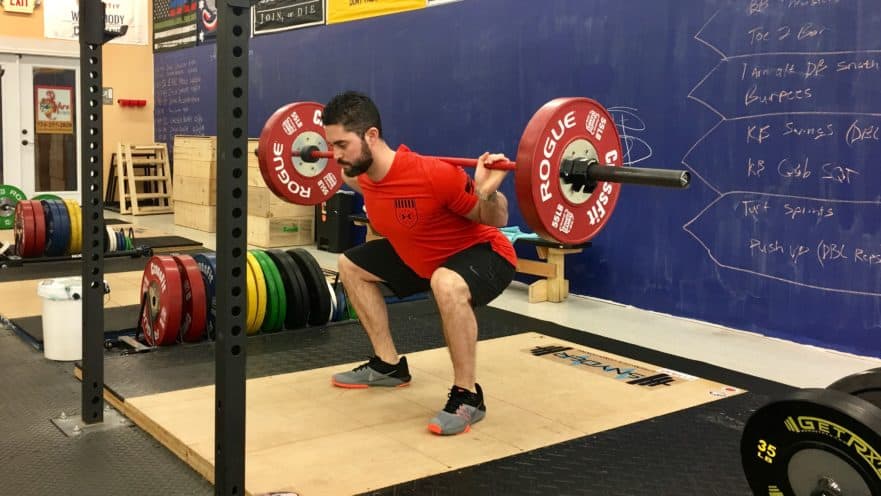We've all heard it: "Don't add strength to dysfunction." While this is a very important concept, it can be taken too far. Do we REALLY need to wait until someone can achieve a bodyweight squat to depth before we add load? WHEN is it acceptable to load the squat? In order to answer these questions, we must first define situations in which it's NOT ok to load.
Do NOT Load the Squat
If There is High Pain Levels. This one should be common sense, but far too often I see both trainees and coaches alike loading the squat through high pain levels. This is simply not acceptable. The brain needs to know that the squat pattern is a threat-free activity. If you consistently squat through pain, the brain can begin to permanently associate the squat with pain, even in the absence of true tissue damage, inflammation, or injury.
Find the optimal stance width, degree of toe out, and trunk angle that does not cause pain. You can also try these drills to help! If it still hurts to squat, seek treatment from a physical therapist. If you are a PT, consider other methods such as manual therapy to decrease threat perception first.
If There are Excessive Form Deficits. Excessive butt-wink, hip internal rotation, knee valgus, and heels coming off the ground all count as reasons to hold off on loading. HOWEVER, I rarely find these to be problems. A good coach will be able to manipulate the squat stance and provide the correct cues to avoid these faults in the bodyweight squat most of the times.
Also, notice I used the word excessive. A small amount of butt-wink is acceptable, and even normal in some people. Is it optimal to load this population under hundreds of pounds? Probably not, but I see no issue with beginning to load if form deviations are only minor. Proper coaching and judgement is key. If it looks horrible, don't load it.

Do NOT load excessive butt-wink. Most coaches can fix this, however, with proper cues.
Do Load the Squat
If Soft Tissue "Tightness" Limits Depth. Here's the deal. On the first coaching session, some people will not be able to perform a bodyweight squat to depth, and there could be many reasons to this. If you have already optimized stance width and toe out, there is no pain/pinching, there are no excessive form deviations, and the trainee is close to achieving depth, it's acceptable to begin loading.
These are your clients that complain "It just feels really tight on the insides of my legs when I'm at the bottom." Their knees are tracking over their toes, there is no excessive lumbar flexion, and they are not complaining of any pain. What should you do? Do I start corrective exercises? How about mobility work? Is it time to move to another exercise?
A Loaded Squat IS Mobility Work
If the only limiting factor in the squat is the sensation of muscular "tightness" (usually in the groin region) why would you not load through this? Loading the squat is the perfect way to create mobility AND stability at the bottom position. Sure, you can begin to perform mobility work (which does have its place) but would we not get more "bang for our buck" if we performed a loaded stretch?
The pitfall of endlessly performing mobility work to achieve squat depth before loading is two-fold: many mobility drills don't possess sufficient load to promote structural adaptation and you now are missing out on the benefits of squatting! If you want to get better depth, you need to practice squatting, and load can augment the effects.
Don't misconstrue my message: I want to reiterate that we are NOT loading through pain, bony blocks, pinches, or excessive form deviations, and a proper warm-up has already been performed. This specifically applies to the population who just feels slight muscular "tightness" in the bottom position.
Conclusion
I agree for the most part that we should not add strength to dysfunction, but this can be taken too far. If the trainee experiences pain during the squat even after stance is optimized, or displays substantial form limitations even after proper coaching, I wouldn't load it. However, if you feel just a little "tight" at the bottom position, get the barbell out. A loaded stretch may be exactly what you need to increase mobility and achieve sufficient squat depth!

